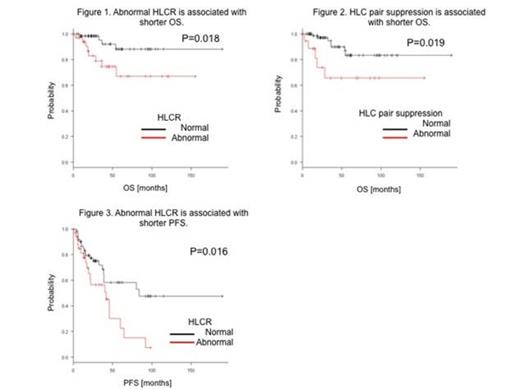Abstract
BACKGROUND: Monitoring of multiple myeloma (MM) patients is required to assess and determine the treatment response. The serum immunoglobulin (Ig) heavy/light chain immunoassays are a new method that enables separate quantification of the different light chain types of each Ig class, i.e., IgGk, IgGl, IgAk, and IgAl. Although the contribution of these tests to disease evaluation has been assessed, available data are still limited. Here, we compared the serum Ig heavy/light chain immunoassays with the conventional methods for disease evaluation.
PATIENTS AND METHODS: Three hundred and three samples were obtained from a total of 101 patients with IgG and IgA type MM recruited at Kameda Medical Center and Kanazawa University Hospital. The median age of the patients was 68 years (range: 44 – 89). The median follow-up was 36 months (range: 2.5 – 189.6). The proportions of patients in International Scoring System (ISS) stages I, II, and III were 25%, 35%, and 40%, respectively. Paraprotein type was IgG in 64 patients (44 Gk, 20 Gl) and IgA in 37 (20 Ak, 17 Al). Samples were taken at various times after treatment and analyzed retrospectively with serum Ig heavy/light chain immunoassays (Hevylite®; Binding Site, Birmingham, UK) on a SPAPLUS® turbidimeter. The heavy/light chain ratio (HLCR) was calculated with the Ig' k (either G or A) as the numerator and compared to normal ranges (IgGk:3.84-12.07g/L; IgGl:1.91-6.74g/L; IgGk/IgGl: 1.12-3.21; IgAk:0.57-2.08g/L; IgAl:0.44-2.04g/L; IgAk/IgAl:0.78-1.94). Results were compared to serum protein electrophoresis (SPEP), immunofixation electrophoresis (IFE), and serum free light chain immunoassays (FLC). HLC-pair suppression was defined as the uninvolved immunoglobulin of the same isotype 50% below the lower limit of the normal range (IgGk, IgGl, IgAk, IgAl). Residual neoplastic plasma cells (MM-PCs) in bone marrow samples were assessed by multicolor flow cytometry (MFC) simultaneously in 140 samples from 64 patients at very good partial response (VGPR), complete response (CR), and stringent CR (sCR). The MFC negativity was defined at a level of < 10-4 MM-PCs. Overall survival (OS) and progression-free survival (PFS) were estimated by the Kaplan–Meier method, and survival was compared using the log rank test.
RESULTS: Myeloma responses were assessed serially after induction therapy and were assigned according to international response criteria. Patients' samples at various responses were: sCR, n = 86 (28%); CR, n = 31 (10%); VGPR, n = 116 (38%); and PR, n = 70 (23%). Normal HLCR was obtained at sCR, CR, and VGPR in 73 (85%), 28 (90%), and 69 (59%) cases, respectively. Discordance in the depth of response between standard electrophoretic methods and HLCR was more commonly seen in IgG compared to IgA MM; possibly reflecting the dose dependent half life of IgG immunoglobulins. In the sera from patients who achieved a CR or better, abnormal HLCR and FLC ratio were seen at rates of 12.8% and 26.5%, respectively. Discordance between normalization of HLCR and FLC ratio was seen in 42% of patients with a CR or better; however, a good correlation between normalization of HLCR and FLC ratio was still observed (Fisher's exact test, P = 0.004). Among the 71 sera from patients with a CR or better in which simultaneous MFC data were available, 16 (22.5%) sera were MFC-negative. Among the patients who achieved a VGPR or better, patients with a normal HLCR had fewer MM-PCs than those with an abnormal HLCR (median 9.8x10-4vs. 46.0x10-4, respectively, P=0.062), although the difference was not statistically significant. Abnormal HLCR in CR samples was seen more frequently in patients with IgA type (19%) than IgG type (7.7%). Longer PFS and OS were observed in patients who achieved HLCR normalization at best response than in those who did not (PFS; 83.8 months vs. 41.8 month, respectively, P = 0.016 and OS; not reached vs. not reached, P = 0.018). When patients at best response were divided into with or without uninvolved HLC pair suppression, the latter group showed significantly better OS compared to the former group (not reached vs. not reached, P=0.019).
CONCLUSIONS: The findings presented here suggest the potential usefulness of heavy/light chain immunoassays for monitoring of myeloma response in patients with IgA myeloma and residual MM-PC assessment at VGPR or better. Presence of abnormal HLCR at best response and HLC pair suppression were also associated with poorer survival.
No relevant conflicts of interest to declare.
Author notes
Asterisk with author names denotes non-ASH members.


This feature is available to Subscribers Only
Sign In or Create an Account Close Modal